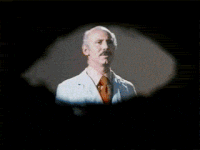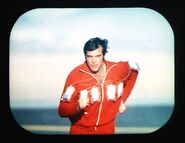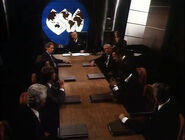
Loss of a man - birth of a legend
Overview[]
The Six Million Dollar Man TV series was preceded by three TV Movies which aired in 1973 on ABC. This period has sometimes been referred to as "Season Zero" by fans, and is complicated by the existence of alternate versions of each telefilm.

The Original Telefilm Title
Movie of the Week[]
On March 7, 1973, a 90-minute telefilm aired as ABC's "Movie of the Week" entitled "The Six Million Dollar Man", starring Lee Majors as Steve Austin, NASA test pilot and astronaut, Darren McGavin as OSO VIP Oliver Spencer and Martin Balsam as Dr. Rudy Wells. The story was derived from author Martin Caidin's novel Cyborg and followed a test pilot who loses most of his limbs in an accident, only to have the government fund mechanical replacements in exchange for government service.
The Universal Studios production, directed and produced by Richard Irving from a script by Howard Rodman (writing as Henri Simoun), eliminated Austin's military rank and cold-bloodedness from the novels in favor of a folksy individualist, temperamentally ill-suited for the government missions expected of him. Rodman also eliminated Caidin's Oscar Goldman, replacing him with Darren McGavin's Oliver Spencer. Gil Mellé would score the first telefilm.
The movie proved popular, as did the character of Austin as portrayed by Majors. Both the Studio and the Network were interested in continuing to develop the Caidin property: Lee Majors would be returning to the role.

The telefilm intro sequence
Suspense Movies[]
After debuting as the Movie of the Week, the original telefilm was moved into ABC's Suspense Theater for subsequent airings, a slot that rotated several properties the network was developing. A new pair of "Suspense Movies" based on the character were developed by an entirely new team, which attempted to reformat The Six Million Dollar Man in several ways.
Replacing Richard Irving in the director's chair would be Russ Mayberry, while Producing would be handled by Michael Gleason. The position of Executive Producer would be added with Glen A. Larson taking charge, who would also write the first of the new films, Wine, Women and War. The third telefilm, The Solid Gold Kidnapping, would be written by Larry Alexander, with Story credit shared with Alan Callou. Stu Phillips (who would work for Larson again to score the original Battlestar Galactica) would compose incidental music for Wine, Women and War, while returning to the franchise for The Solid Gold Kidnapping would be original telefilm composer Gil Mellé.
Martin Caidin's Oscar Goldman was back for the new films, played by Richard Anderson, as was Steve's Air Force rank, yet Caidin's OSO would become the OSI. Rudy Wells would return, now played by Alan Oppenheimer. Steve Austin's character would become more of a James Bond type hero, a ladies man saving the world before breakfast. This aspect of Steve's character would be reduced for Season One.
An introductory sequence was created for the latter two telefilms, ostensibly recapping events of the original, while in fact retroactively inserting Richard Anderson and Alan Oppenheimer into those events, and providing a cursory and inaccurate recap of the lifting body accident. The sequence concluded with a montage of shots from the first two telefilms, accompanied by Dusty Springfield singing: "Six Million Dollar Man." This sequence and particularly the song can be startling to those accustomed to the show intro that would follow - as it was to fans of the first telefilm who were not expecting such a shift in tone. Nonetheless, the telefilm intro was the first attempt at conveying in a single sequence the story, concept and personality of the show. As such, it provides a cliff-notes version of the differences between this period of development and the show that would follow. It also debuted a graphic of the show's title that would be used for marketing purposes beyond the telefilm period, with the show title in a receding trapezoid (seen above in the image: "the telefilm intro sequence"), similar to the style that would be used for marketing Star Wars four years later.
The new telefilms would air in October and November of 1973, and while the response was mixed, leading to an end to the 90 minute series, neither the studio nor the network were done yet. Before the third telefilm aired, still another team would develop a take on the property, this time with a winning formula, producing a season of 13 one-hour episodes. The Six Million Dollar Man, as a television series, was born.
Telefilms[]
Syndicated Revisions[]
Some years later, when the show was being packaged for syndication, the three 90-minute telefilms would be reconfigured as 2-hour, 2-part episodes of the series. The latter two would gain a "Part II" and an injection of new footage (of varying narrative relevance), with the original telefilm receiving a more thorough makeover, plus a new name, The Moon and the Desert, referencing the film's ending and the new scenes on the Moon added to the beginning (lifted from later episodes).
This resolved the problem of selling 90-minute telefilms as part of a package of one-hour episodes, but the revised versions introduced a host of new problems.The individual articles for each film have a detailed list, but in general the issues relate to the introduction of new material to the films, that bring significant stylistic and continuity conflicts with them. The editing of existing material, both picture and sound, is an additional factor.
While the preponderance of these changes were problematic, there were several notable upgrades. The film for the new release was retransferred and possibly reprinted, eliminating the black crush that had troubled earlier prints.
The sound was remixed, and with five years between and televisions beginning to have better sound, the result was a less brash, more nuanced mix. The music was completely re-edited for the first two telefilms, in general duplicating some tracks and eliminating others, and reducing emphasis in many areas. Notably, Steve's making a fist with his new bionic hand in The Six Million Dollar Man (Pilot) and particularly in Wine, Women and War, where many scenes such as Oscar's debut have altered music that lessens the dramatic impact of these important moments. Gil Mellé's score for the third telefilm was replaced entirely by tracks composed by series composer Oliver Nelson. Bionic sounds, a later development, were introduced without consistency.
The series' show intro replaced the telefilm intro in the case of telefilms two and three, but more problematically it was attached to the beginning of The Moon and the Desert - providing a spoiler for the narrative to come, a "dumb show" as it were (although it should be stated that the syndicated version is not really intended to be the first episode viewed, given that it is presented as an extended flashback, narrated by Rudy Wells). The version of the series intro used was the Season 4/5 variant, and for the first of the three, Martin E. Brooks is allowed to keep his title shot, perhaps due to his footage being inserted into the new cut; the latter two have an Alan Oppenheimer credit stepping on that of Martin E. Brooks. Balsam receives credit after the break in The Moon and the Desert. as does Lee Majors - despite receiving his usual credit in the intro. Balsam, despite not having played Rudy for several years and in spite of Brooks being the current actor, was brought back to record narration for The Moon and the Desert in order to retain continuity with his presence in the episodes.
An effort was made to inject the character of Carla Petersen, a character with continuity problems of her own, into the narrative of the second and third telefilms. This places her immediately after Jean Manners in the sequence of episodes, seemingly countering the notion that these are the same character, and rather that it was Carla all along.
The product of these changes were a well-engineered yet poorly devised and edited trilogy of two-parters that, as replacements for the telefilms, had little of their original spark or quality. While most fans identify the telefilms as they originally aired as definitive, Universal has phased these versions out in favor of their 2-hour counterparts.
The announced Time Life North American DVD release of The Six Million Dollar Man, scheduled for November 2010, is to include both the original TV movie versions and two-part syndicated versions of the three films.
| The Six Million Dollar Man: 1973 TV Movies | |
| Followed by: | |
| Season 1 | |



